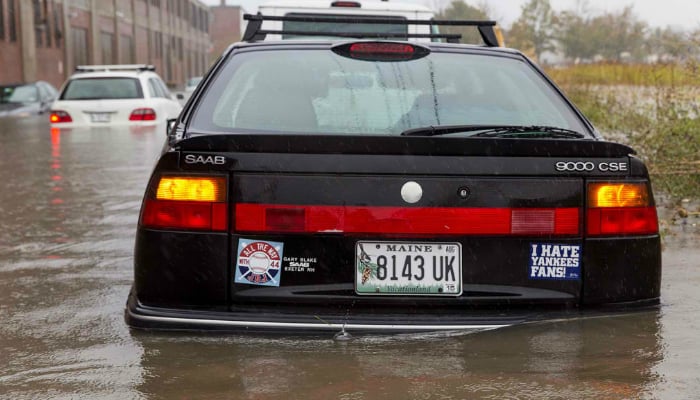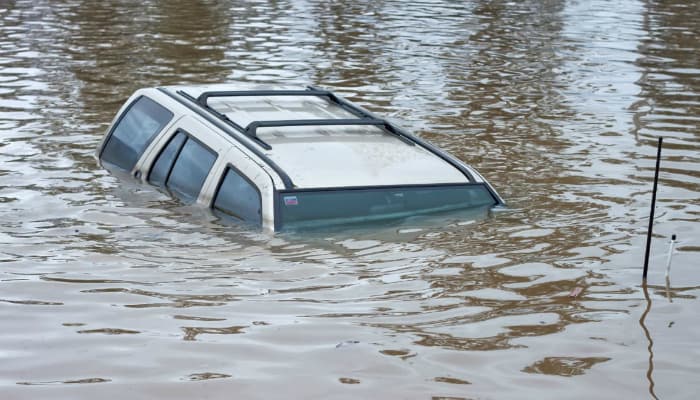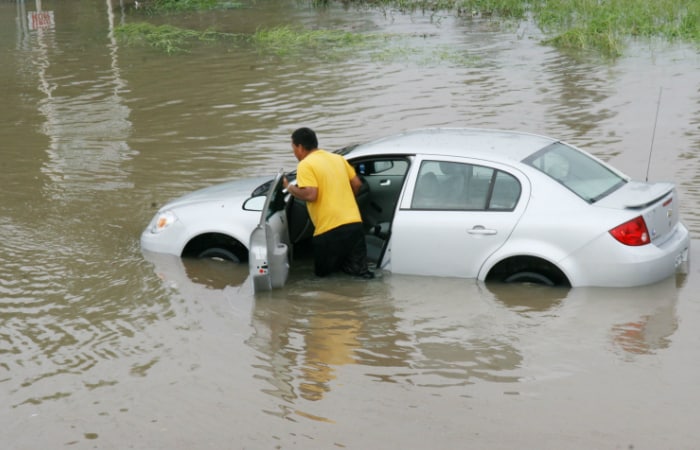One of the scariest scenarios drivers and passengers can experience is being trapped inside a car when flood suddenly covers the streets. If you have no knowledge of how to handle this situation, your predicament would be so much worse. Should you stay inside until help arrives? Or, is it necessary for you to go out immediately and find help? Since there are a lot of possible solutions, some of which are completely wrong, we are here to guide you on what to do in a flood when you are inside a car.
Just a bit of advice before we proceed on what to do in a flood: never underestimate shallow waters. Based on a certain natural hazard guideline released by the Federal Emergency Management Agency, six inches of water can already contribute to a steering failure, making it hard for you to control your car. Meanwhile, one foot of water can surprisingly make cars gradually float away. Lastly, two feet of water is enough to quickly sweep away vehicles – even big ones such as SUVs and pickup trucks.
See, as soon as the car is surrounded by water, you have all the right to be concerned but never panic. Do not wait for the flood to rise to a deadly level. You really have to remember the following guidelines on what to do in a flood if it is still rising around your car:
Be visible
No, we do not mean going to the roof of your car and wave your hands up in the air. You can stop ridiculous ideas such as this one by staying calm. The first thing you have to do is to make your car visible by turning on the hazard lights and the headlights. If you can already spot emergency personnel, you are so lucky. These modern heroes will surely notice the lights from your car and help you immediately. Wait for them to reach you.

Do not secure yourself inside
Ironically, you have to be 100% free from any constraint inside the car. We are specifically referring to your seat belt. Do not believe the notion that the seat belt would keep you safe when the vehicle starts floating away. After all, once the car floats, you are already in big trouble. As soon as you see water surrounding your car, stop the vehicle and release yourself from the seat belt immediately. Also, unlock all doors. If there are authorities nearby, they can easily open your car door and save you.
Remove layers of clothing
If you are simply wearing two pieces of clothes, top, and bottom, disregard this tip. However, if you are wearing a jacket and other types of layers, immediately remove them all. This initiative keeps you from sinking if you have to swim.
Open a window.
Now, let’s start thinking about worst-case scenarios. What if you are stranded in the middle of the flood without safety personnel around you? Before you even get to this point, it is always a good idea to stay indoors whenever it rains.
However, when push comes to shove, lower one window but not in an abrupt way. Just do it slowly. As long as the car is not yet underwater, electric windows usually work even in a flood. Once you successfully lower the window, climb out straight away. Find a high ground and contact 911.
Go to plan B if you cannot open a window
Worse, there is a possibility that you cannot open the windows anymore, especially if they are electronic ones. So, you have to resort to car doors. Forget about the passenger compartment getting wet. That is the least of your worries in emergency situations. If you are too weak to open the car door, break a window. Make sure to bring a glass breaker with you at all times. It is hard to forcefully shatter a window inside a compact space if you use other tools. Just a heads-up, these tips are only applicable if the water is still at a low level.
Of course, you may suffer from wounds when you climb over a shattered glass window. However, your number one priority is to keep breathing. Wounds are nothing compared to drowning.

Unfortunately, car doors are impossible to open when the water level is already too high. Why? Two words: water pressure. You cannot open a car door if there is massive pressure outside. A solution is to equalize the pressure between the inner and outer part of the car. To achieve this, there is nothing left for you to do but wait for water to fill your car. Hold your breath once submersion is complete and open the door at once. That is why we told you to unbuckle your seat belt, unlock the doors, and avoid waiting for water to rise up unless the car is already submerged. As you can see, not only do you have to take driving lessons. Knowing how to swim is essential.
Water pressure is also the reason why you cannot break a window during your car’s submersion. The explosion of shattered glass will severely hurt you.
Leave your possessions behind
Unless the water level is still low, forget about your belongings inside the car. You cannot swim properly if you are busy carrying your bag. If you can still walk on water, prioritize your phone so you can call for help anytime.
Do not save your car
Just because you can still stand on water does not mean you can push your car towards a safe place. The main reason why we are advising you to get out of your car immediately is to find a high ground. Flood can still rise to an extreme level so better avoid that pronto. So what if your car is expensive? As a car owner, you should be totally updated about storm signals.
When the flood finally subsides, do not go back to your vehicle. You might use a lot of time starting or pushing your car until the water level rises again. Besides, emergency personnel always use proper means of taking cars to a safer place.
What to Do in a Flood When You’re in a Car
In summary, the first solution is to keep calm. When you are calm, your mind easily remembers what to do in a flood when you are inside a vehicle. Your main goal is to get out of the car and go to a higher place if there are no authorities around. Never wait for the water level to rise up. In case you haven’t noticed from our guidelines, the solutions progress from the easiest ones to the worst-case scenarios. Do not let yourself be exposed to a more dangerous situation. Lastly, always catch up with weather updates and learn how to swim – just in case.







